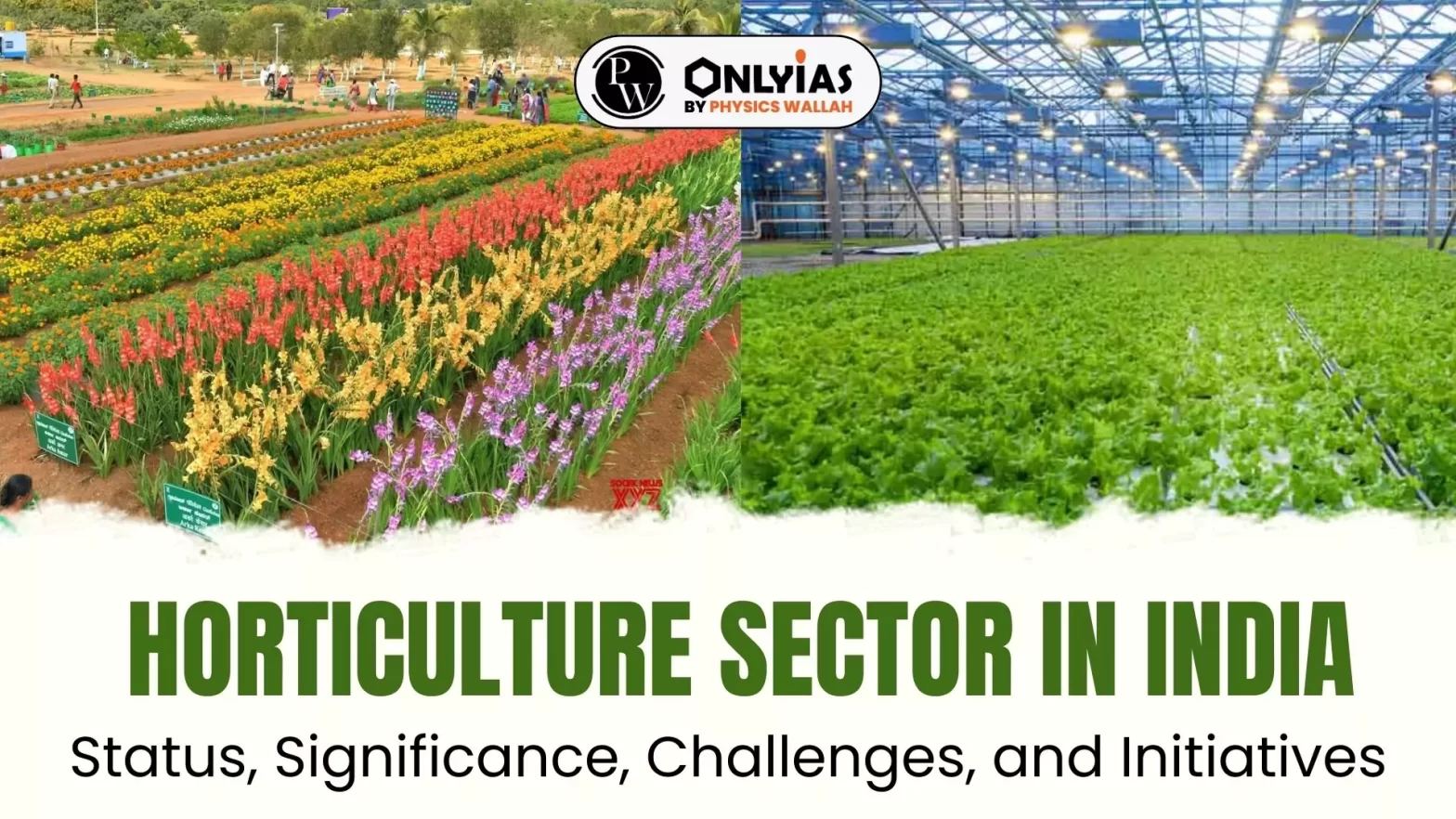Horticulture Sector In India: Status, Significance, Challenges, and Initiatives

This editorial is based on the news “ Ministry of Agriculture and Farmers’ Welfare releases third advance estimate of area and production of various horticultural crops for the year 2022-23 ” which was published in the Indian Express. The Ministry of Agriculture and Farmers’ Welfare released the third advance estimate of area and production of various horticultural crops for the year 2022-23.
- Horticulture can be defined as the branch of agriculture concerned with intensively cultured plantsdirectly used by people for food, medicinal purposes, or aesthetic gratification.
- According to the Agricultural and Processed Food Products Export Development Authority (APEDA) , India ranks second in fruit and vegetable production after China.
- M. H. Marigowda is considered the father of horticulture in India.
- Share in GDP: Around 30.4% to Agriculture’sGross Domestic Product.
- Share in GVA: Around 33% to the agriculture Gross Value Added (GVA) .
- Sector Growth: Rising annually by 1.37% to 351.92 million tonnes in 2022-23 .
- Production Status: In 2021-22, the total production was around 341.63 mn tonnes, with fruit and vegetable production at around 107.10 mn tonnes & 204.61 mn tonnes respectively.
- Increase in Production: For the year 2022-23 is 355.25 mn tonnes, which is an increase of about 8.07 mn tonnes from the year 2021-22 (347.18 mn tonnes).
- India as Global Leader: India has emerged as a world leader in the production of Mango, Banana, Guava, Papaya, Sapota, Pomegranate, Lime & Amla (Indian Gooseberry) .
- Major Fruit Export Destination: The major destinations include Bangladesh, UAE, Nepal, Netherlands, Malaysia, Sri Lanka, the UK, Oman, and Qatar.
- High Production: India is currently producing about 320.48 mn tonnes.
- Low Inputs: Mostly grown on small patches of land and it also ensures quick returns to farmers.
- Employment Generation: It creates job opportunities, expands the agricultural activities, and generates higher incomes. Cashew industry alone employs over 5.5 lakh workers annually.
- Industrial Development: It directly or indirectly serves as raw material for many industries.
Challenges Faced by the Horticulture Sector In India
- Capital Intensive Nature: The limited outreach of farm insurance and farm mechanisation, combined with a lack of access to institutional credit for small and marginal farmers.
- Infrastructure Issues: Lack of proper irrigation facilities is a crucial limiting factor.
- Poor Linkages of Value Chain: Poor logistics and lack of equitable cold storage and warehousing facilities contribute to delays and wastages.
- Poor Quality of Seeds: According to the National Horticultural Board, the inadequate availability of quality planting material was one of the primary reasons for the low productivity.
- Pests and Diseases: Horticultural crops in India face the possibility of fungal infection and bacterial blights spreading fast and wide.
- Poor Coordination Between Horticulture Departments: There is a lack of coordination among state horticulture departments.
- Poor Research and Development: Presently, the capacity utilisation is only around 25 to 30%.
- Insignificant Share in Global Trade: India’s trade is only 1% of the global horticulture trade.
- Tariff Barriers: Indian horticulture products face tariff barriers in developed countries, along with non-tariff, phytosanitary requirement-related barriers.
Government Interventions in Horticulture Sector
- Mission for Integrated Development of Horticulture : For the holistic growth of the sector.
- Horticulture Area Production Information System (HAPIS): A web portal.
- CHAMAN (Coordinated Horticulture Assessment and Management using geo-informatics): S ound methodology for estimation of Horticulture crops .
- National Horticulture Board (NHB): To improve integrated development .
- Cluster Development Programme: To promote integrated and market-led development.
- Pradhan Mantri Krishi Sinchayee Yojana (PMKSY): To address the irrigation problem .
- Agricultural Marketing and Farmer Friendly Reforms Index : It ranks states and union territories based on implementing provisions.
- Pradhan Mantri Fasal Bima Yojana (PMFBY): To reduce crop losses.
Way Forward to the Indian Horticulture Sector
- Institutional Support : Associated institutes need to provide financial assistance. Commercial banks and Export-Import Banks may extend packing credit by providing credit-plus services.
- Strengthening Post-Harvest Mechanism: A better cold chain network and access to refrigerated transport is required.
- Accessibility of Good Quality Seeds: By providing farmers with easier access to superior seedlings and rootstock through government subsidies and initiatives.
- Investment in Agri-infrastructure: By capitalising the MIDH and Operation Greens.
- Focus on Reach: Horticulture products should reach the airport cargo handling facility within three hours to reach final destination in the Middle East , East Asia , and European markets.
- Co-operatives in Horticulture: To harness market efficiency and boost exports.
| Mains Question: What are the major challenges hindering growth as well as the future opportunities that can promote development of India’s horticulture sector? (10 Marks, 150 Words) |
| Must Read |
| NCERT Notes For UPSC | UPSC Daily Current Affairs |
| UPSC Blogs | UPSC Daily Editorials |
| Daily Current Affairs Quiz | Daily Main Answer Writing |
| UPSC Mains Previous Year Papers | UPSC Test Series 2024 |


